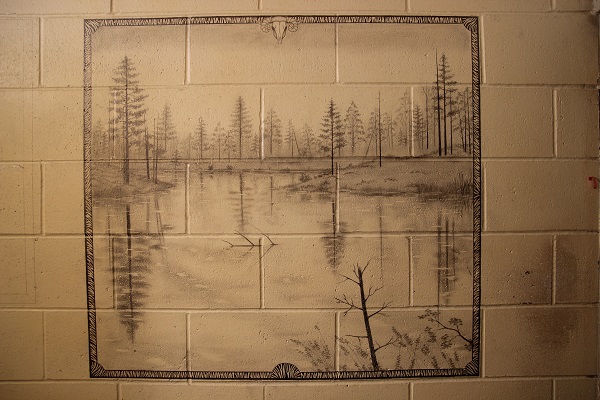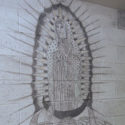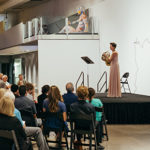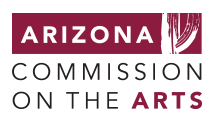Perspectives is an on ongoing series of interviews and check-ins with recipients of our Artist Research and Development Grant (ARDG). Today we speak with 2014 ARDG recipient Thomas Eldridge of Phoenix.
Four years later, Eldridge began working in earnest to document these murals, drawn over a number of years by men incarcerated in the now-closed Madison Street Jail in downtown Phoenix, and in January 2014, he received an Artist Research & Development Grant from the Arizona Commission on the Arts in support of this documentary/art video project. Titled Inside Madison, the project is now in the final stages of production.

Madonna, by unknown artist.
“What makes these cell walls so unique is twofold,” Eldridge explains in his grant application. “Prison policy throughout the country dictates that inmates are never allowed to draw on walls. The fact that so many cells on multiple floors are covered with drawings and writings suggests an authorized break from that policy, perhaps because both prisoners and guards knew the facility was going to close.” Madison Street Prison was closed in 2005.
It was the murals themselves, however, more than the circumstances that allowed for their creation, that truly captured Eldridge’s imagination–their content and artistic quality, but also, their medium. The artist inmates had only one implement freely available to them: golf pencils.
With Inside Madison nearing completion and Madison Street Jail about to be converted into county office space, we thought it a good time to catch up with Thomas Eldridge.
Can you catch us up on where the project currently stands? How far along are you toward completion? What is your primary, short term goal at this stage?
Production on the documentary is nearly complete. I have one, maybe two, interviews to do and some field footage to shoot. This stage will be completed by the end of January 2018. I spent several long days last December completing the documentation of imagery inside Madison. It was a mad rush as the County had decided to renovate the facility and was planning to close off access to the building after January 1 of this year. I also just recently created a website and began an on-line fundraising campaign through GoFundMe.
I am currently focusing my efforts on music, which will play a vital role in the documentary. I have secured copyright release to use two beautiful, haunting pieces performed by a group using stringed bows on a vibraphone. I was given permission to use a song by Country Joe and the Fish from their 1967 album, Electric Music for the Mind and Body. There are also several local musicians I am working with for original scoring. I plan to begin editing a rough cut in February and hope to have the documentary ready for viewing by late spring, 2018.
In the nearly five years since you began production, how has the scope, depth, and/or focus of the story changed? Are you still telling the same story that you set out to tell at the beginning?
My initial plan was to create a lengthy montage of all the images set to different pieces of music by theme: religion, time, drugs, gangs, cultural identity, and such. Then one day while shooting on the fifth floor, the DO (detention officer) I was with discovered a prescription label stuck to a wall above the sink. She did some research and discovered he was at the Lewis Prison in Buckeye. Finally, I had a name of a person who had spent time in this cell and may have information on who did some of the drawings on the cell walls. That was in 2013. The project began morphing.
Since then I visited with him at Lewis, waited for his release in May 2016, and videotaped him inside the cell at Madison talking about a large mural he had drawn above his bunk. He told me what inspired him to begin drawing, how he kept his golf pencil sharpened, what he used to draw straight lines, and the cramped body positions he endured for hours while drawing the image, which is based on an 18th century painting by William Blake titled The Ancient of Days.
William Blake’s Ancient of Days (left) and Creator of Heavenly Lights (right), by Robert D’Adarrio.
I’ve also discovered a second inmate who had drawn murals inside Madison. He is serving a life sentence at Eyman Prison in Florence. DOC will not allow me to go in with a camera and videotape him. So I am in the process of setting up a recorded phone interview with him.
One of my interviews with MCSO staff was a former Sergeant who specialized in gangs and gang symbols. She gave me insightful information on much of the gang imagery drawn on the walls. All of this added information has provided an unanticipated depth and dimension that has transformed my simple plan of a music montage into a one hour documentary.
Throughout your application you talk about how this project would push your craft to a new level, requiring you to develop new skills and engage in new practices. Looking back, what is one example you would give of an area where your skills have been expanded or enhanced through your work on this project?
When I first began documenting the images inside Madison I was using a camera shooting standard definition video. I left Phoenix for two years. When I came back in 2011 Hi-Def cameras were more affordable and now the norm for videographers, so I reshot much of what I had already captured in high definition. During that time filmmakers were discovering the powerful Hi-Def features in DSLR cameras. These small cameras were small, used a wide assortment of interchangeable lenses, and shot great video. Again, I went back into many cells and reshot (for a third time) large murals using a wide angle lens on my new DSLR camera and utilizing peripheral gear, such as a slider to give the shot a slow, steady feel as if you’re walking into the cell. Adapting and learning to use new technology is essential for anyone aspiring to create art.
A second challenge was with interviewing subjects. Two discoveries I made: One is that many of the people who worked or had worked at Madison and had great stories to tell simply did not want to be interviewed. They would talk to me all day about their experiences, but they wouldn’t talk on camera. The other revelation is my discovery that interviewing someone is truly a skilled art. While my interviews produced usable material, they fell short of what I had hoped to get. This has important consequences. Instead of using sound bites from interviews to thread elements of the documentary together and give the story a flow, I have to write a script and use a voice over for much of this.
I have been talking about the production process, but there are many other challenging areas of putting a film together: website creation, fundraising, negotiating copyright clearances for music, and marketing, to name a few. It’s expensive. While I’ve used much of my own savings, the Commission’s grant has been instrumental in paying for access to Madison as well as hourly wages for MCSO staff to escort me and get me inside closed cells.


A landscape drawing by William Mitchell
Mural by an artist known only as “Grandel”
Documentaries tend to take a long time to come together and during that time a lot can change: intended interview subjects may move, pass on, or become less cooperative; spaces and reference materials may become less accessible; planned lines of inquiry may prove less fruitful than anticipated. Can you talk briefly about how you have navigated such challenges?
In my grant application with the Arizona Commission on the Arts I stated that the project would be completed in one year. I’m in my fifth year working on this doc. I have spent well over 100 hours inside Madison. People ask me why I’m doing it. Of course, I want to share with viewers the amazing imagery inside a facility that sat as a catacomb for many years. But Madison is more than just the art on the cell walls. It’s the smell of the place, the way it feels, the loud silence inside an empty building, the way the light falls on the walls as it seeps through the narrow cell windows.
There is a kind of spirituality I find inside Madison. Since the first time I laid eyes on one of the murals, I feel that I’ve been chosen to tell its story. It’s like a voice, one that I must serve. Madison is currently undergoing restoration. It will be converted to office space for the County. All those murals, the drawings, the poetry will be forever destroyed. Inside Madison will be a testament to the confined human spirit in all of its anger, confusion, hope… and beauty.
You can learn more about Inside Madison on the documentary’s official website.
Thomas Eldridge is currently raising funds to complete Inside Madison through a GoFundMe Campaign.
Related Posts
Perspectives is an on ongoing series of interviews and check-ins with recipients of our Artist Research and Development Grant (ARDG). Recently, we spoke with Phoenix-based public artist Danielle Foushée about "Invitation," a piece installed at the entrance to Tempe Beach Park in October 2017. 2017 Artist R&D Grant recipient Julie Comnick's Arrangement for a Silent Orchestra will be open at the Coconino Center for the Arts from January 9 through February 10, 2018. There will be a members preview reception on Saturday, January 6, and public opening reception on Saturday, January 13. Comnick will perform a solo violin piece at both receptions. "There is a kind of spirituality I find inside Madison. Since the first time I laid eyes on one of the murals, I feel that I've been chosen to tell its story. It's like a voice, one that I must serve.... Inside Madison will be a testament to the confined human spirit in all of its anger, confusion, hope... and beauty." Perspectives is an on ongoing series of interviews and check-ins with recipients of our Artist Research and Development Grant (ARDG). Today we speak with 2017 ARDG recipient Amy Carpenter and her creative partner Stacey Reed Hanlon. Perspectives is an on ongoing series of interviews and check-ins with recipients of our Artist Research and Development Grant (ARDG). Today we speak with 2017 ARDG recipient Johanna Lundy of Tucson.
Perspectives: Danielle Foushée

Arrangement for a Silent Orchestra at Coconino Center for the Arts

Perspectives: Thomas Eldridge

Perspectives: Amy Carpenter and Stacey Reed Hanlon

Perspectives: Johanna Lundy




